Study of Eddy Current Testing Ability on SLM Aluminium Alloy
Abstract
1. Introduction
2. Materials and Methods
| Parameter | Symbol | Value | Unit |
|---|---|---|---|
| Laser power | P | 275 | W |
| Scanning velocity | v | 1150 | mm·s−1 |
| Hatching distance | d | 80 | μm |
| Layer thickness | tL | 30 | μm |
| Energy input (1) [22] | ε | 99.64 | J·mm−1 |
| Scanning strategy | Stripe (Figure 2) | ||
| Gas protection | Argon (Ar) |
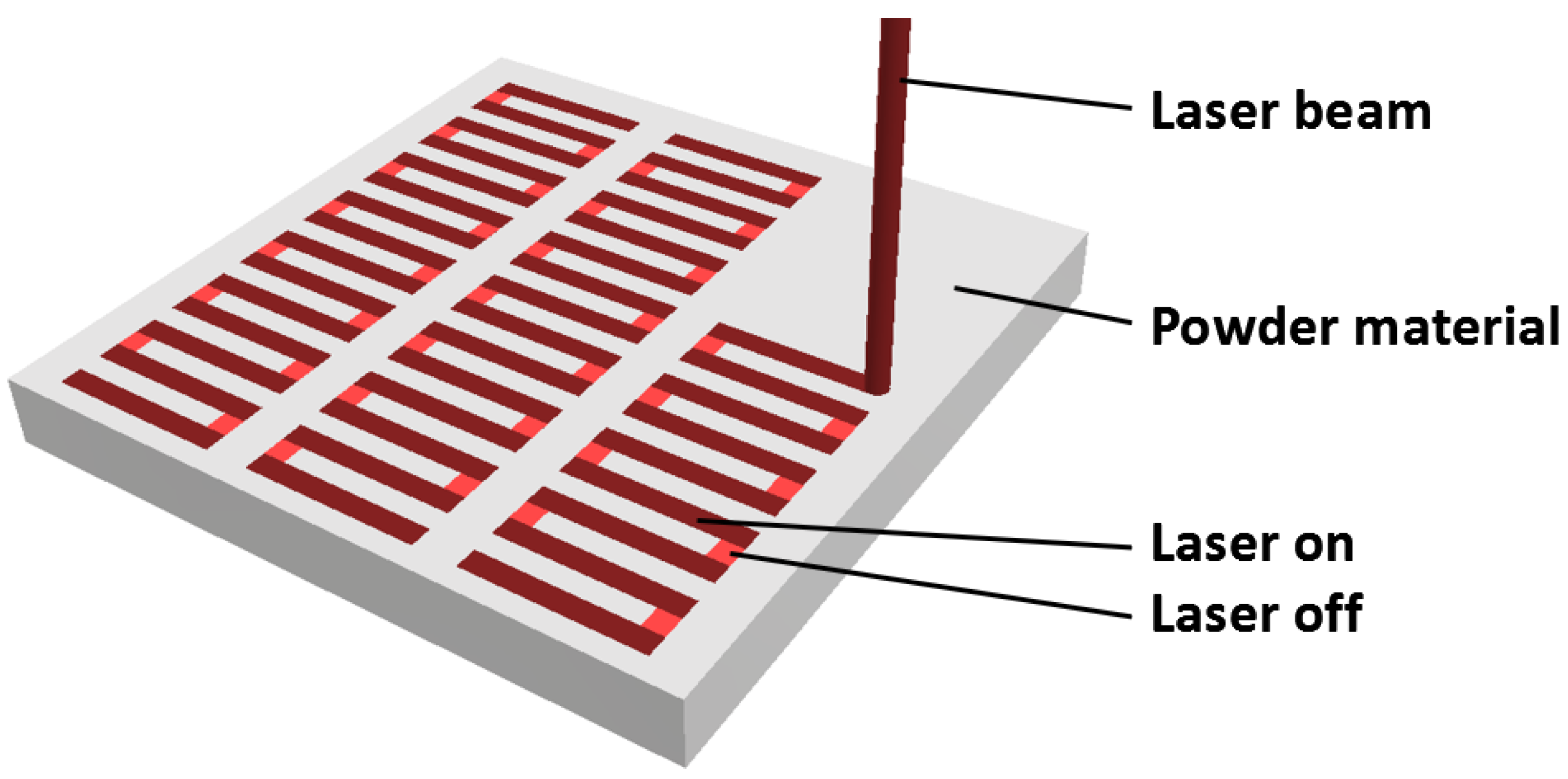
3. Results
3.1. Evaluation of ECT Probe Characteristics
3.1.1. Reactance (VMAX)
3.1.2. Resistance (HMAX)
3.1.3. Lift-off Effect
3.1.4. Skin Effect
3.2. Defectoscopy
3.2.1. Areas with Unmolten Powder
3.2.2. Surface-Reaching Artificial Defects
3.2.3. Subsurface Artificial Defects Unfilled with Powder
3.2.4. Subsurface Artificial Defects Filled with Powder
4. Discussion
5. Conclusions
- The lift-off effect diagrams of selected probes for the AlSi10Mg alloy were expressed, with a prior definition of reactance (VMAX) and resistance (HMAX) variation dependent on probe-surface distance.
- Electrical conductivity as an important material parameter was determined for the AlSi10Mg alloy using an ECT device, with subsequent calculation of standard penetration depth in the frequency range of the used probes (0.3–100 kHz).
- The IMPEDANCE regime was shown to be applicable solely for surface-reaching defects and possibly for larger subsurface defects (5 mm in diameter). Also, a regime was used for distinguishing signal variations based on the presence of areas with various densities of unmolten powder (specimen 1). For other types of defects, a simpler SWEEP regime is suitable, and hence, a lower level of data interpretation is reached.
- Maximal reached depth was 3.50 mm at 0.9 kHz frequency, according to standard penetration depth calculation. D4 defects (1 mm diameter) at 6.5 mm in depth of specimens 5 and 7 caused slight signal deviation; however, its magnitude is negligible and hard to analyse, which confirms difficulties in the identification of defects in the subsurface layers of AlSi10Mg material.
- The smallest detected surface-reaching defects were 0.5 mm in diameter (hole type) and at 0.5 mm in depth (notch type). For subsurface defects, the smallest detected diameter was 0.7 mm, in the case of both types, empty holes and spherical cavities filled by unmolten powder, with a slight signal deviation and setting of higher values of the GAIN parameter mainly in the case of the second one mentioned.
- The dependency of signal curves based on defect characteristics was expressed in the form of a single peak for the notch-type defect in both regimes, a double peak for spherical defects within the SWP regime and a wave-type curve for the IMP regime. A curve development for these types was described with simulation interpretation.
Author Contributions
Funding
Institutional Review Board Statement
Informed Consent Statement
Data Availability Statement
Conflicts of Interest
References
- García-Martín, J.; Gómez-Gil, J.; Vázquez-Sánchez, E. Non-destructive techniques based on eddy current testing. Sensors 2011, 11, 2525–2565. [Google Scholar] [CrossRef]
- AbdAlla, A.N.; Faraj, M.A.; Samsuri, F.; Rifai, D.; Ali, K.; Al-Douri, Y. Challenges in improving the performance of eddy current testing. Meas. Control 2019, 52, 46–64. [Google Scholar] [CrossRef]
- Saari, M.M.; Nadzri, N.A.; Halil, A.M.; Ishak, M.; Sakai, K.; Kiwa, T.; Tsukada, K. Design of eddy current testing probe for surface defect evaluation. Int. J. Automot. Mech. Eng. 2019, 16, 6357–6367. [Google Scholar] [CrossRef]
- Saddoud, R.; Sergeeva-Chollet, N.; Darmon, M. Eddy Current Sensors Optimization for Defect Detection in Parts Fabricated by Laser Powder Bed Fusion. Sensors 2023, 23, 4336. [Google Scholar] [CrossRef]
- Mohseni, E.; Habibzadeh Boukani, H.; Ramos França, D.; Viens, M. A study of the automated eddy current detection of cracks in steel plates. J. Nondestruct. Eval. 2020, 39, 6. [Google Scholar] [CrossRef]
- Sophian, A.; Tian, G.; Fan, M. Pulsed eddy current non-destructive testing and evaluation: A review. Chin. J. Mech. Eng. 2017, 30, 500–514. [Google Scholar] [CrossRef]
- Repelianto, A.S.; Kasai, N.; Sekino, K.; Matsunaga, M. A uniform eddy current probe with a double-excitation coil for flaw detection on aluminium plates. Metals 2019, 9, 1116. [Google Scholar] [CrossRef]
- Romero-Arismendi, N.O.; Pacheco, E.R.; Lopez, O.P.; Espina-Hernandez, J.H.; Benitez, J.A.P. Classification of Artificial Near-Side Cracks in Aluminium Plates Using a GMR-Based Eddy Current Probe. In Proceedings of the 2018 International Conference on Electronics, Communications and Computers (CONIELECOMP), Cholula, Mexico, 21–23 February 2018; IEEE: Piscataway, NJ, USA, 2018; pp. 31–36. [Google Scholar] [CrossRef]
- Bento, J.B.; Lopez, A.; Pires, I.; Quintino, L.; Santos, T.G. Non-destructive testing for wire+ arc additive manufacturing of aluminium parts. Addit. Manuf. 2019, 29, 100782. [Google Scholar] [CrossRef]
- Sekar, K.; Vasanthakumar, P. Characterization and Eddy Current Flaw Detection of Dissimilar Aluminium Butt Joint by Friction Stir Welding. Mater. Sci. Forum 2023, 1110, 103–113. [Google Scholar] [CrossRef]
- Ren, Y.; Zeng, Z.; Jiao, S. Eddy current testing of CFRP/Aluminium honeycomb sandwich structure. Nondestruct. Test. Eval. 2024, 1–13. [Google Scholar] [CrossRef]
- Měsíček, J.; Čegan, T.; Ma, Q.P.; Halama, R.; Skotnicová, K.; Hajnyš, J.; Juřica, J.; Krpec, P.; Pagáč, M. Effect of artificial aging on the strength, hardness, and residual stress of SLM AlSi10Mg parts prepared from the recycled powder. Mater. Sci. Eng. A-Struct. 2022, 855, 143900. [Google Scholar] [CrossRef]
- Sun, W.; Kasa, T.; Hatsukade, Y.; Yonehara, M.; Ikeshoji, T.; Kyogoku, H. Quality assessment of SUS316L fabricated by metal additive manufacturing with eddy current inspection. NDT E Int. 2023, 138, 102901. [Google Scholar] [CrossRef]
- E Farag, H.; Toyserkani, E.; Khamesee, M.B. Non-Destructive Testing Using Eddy Current Sensors for Defect Detection in Additively Manufactured Titanium and Stainless-Steel Parts. Sensors 2022, 22, 5440. [Google Scholar] [CrossRef] [PubMed]
- Henry, T.C.; Phillips, F.R.; Cole, D.P.; Garboczi, E.; Haynes, R.A.; Johnson, T. In situ fatigue monitoring investigation of additively manufactured maraging steel. Int. J. Adv. Manuf. Tech. 2020, 107, 3499–3510. [Google Scholar] [CrossRef]
- Guo, S.; Ren, G.; Zhang, B. Subsurface Defect Evaluation of Selective-Laser-Melted Inconel 738LC Alloy Using Eddy Current Testing for Additive/Subtractive Hybrid Manufacturing. Chin. J. Mech. Eng. 2021, 34, 111. [Google Scholar] [CrossRef]
- Spurek, M.A.; Luong, V.H.; Spierings, A.B.; Lany, M.; Santi, G.; Revaz, B.; Wegener, K. Relative density measurement of PBF-manufactured 316l and AlSi10Mg samples via eddy current testing. Metals 2021, 11, 1376. [Google Scholar] [CrossRef]
- Spurek, M.A.; Spierings, A.B.; Lany, M.; Revaz, B.; Santi, G.; Wicht, J.; Wegener, K. In-situ monitoring of powder bed fusion of metals using eddy current testing. Addit. Manuf. 2022, 60, 103259. [Google Scholar] [CrossRef]
- Kasa, T.; Sun, W.; Hatsukade, Y.; Yonehara, M.; Ikeshoji, T.T.; Kyogoku, H. Eddy Current Testing Based Non-Destructive Inspection for Metal 3D Additive Manufacturing Objects With HTS-SQUID. IEEE T. Appl. Supercond. 2023, 33, 1600504. [Google Scholar] [CrossRef]
- Özer, G.; Tarakçi, G.; Yilmaz, M.S.; Öter, Z.Ç.; Sürmen, Ö.; Akça, Y.; Coşkun, M.; Koç, E. Investigation of the effects of different heat treatment parameters on the corrosion and mechanical properties of the AlSi10Mg alloy produced with direct metal laser sintering. Mater. Corros. 2020, 71, 365–373. [Google Scholar] [CrossRef]
- Center of 3D Printing Protolab. Data Sheet: AlSi10Mg; Center of 3D Printing Protolab: Ostrava, Czech Republic, 2024. [Google Scholar]
- Gu, D.; Shen, Y. Balling phenomena in direct laser sintering of stainless steel powder: Metallurgical mechanisms and control methods. Mater. Des. 2009, 30, 2903–2910. [Google Scholar] [CrossRef]
- Meander Stripe and Chessboard Hatching Pattern. Available online: https://www.renishaw.com/resourcecentre/en/details/Meander-stripe-and-chessboard-hatchings-pattern--95492?lang=en (accessed on 2 May 2024).
- NORTEC 600 Eddy Current Flaw Detector User´s Manual. Available online: https://manualzz.com/doc/59581713/olympus-nortec-600-user-manual (accessed on 2 May 2024).
- 304 Stainless Steel. Available online: https://www.matweb.com/search/DataSheet.aspx?MatGUID=abc4415b0f8b490387e3c922237098da (accessed on 2 May 2024).
- Copper, Cu; Annealed. Available online: https://www.matweb.com/search/datasheet.aspx?matguid=9aebe83845c04c1db5126fada6f76f7e (accessed on 2 May 2024).
- Kobayashi, N.; Yamamoto, S.; Sugawara, A.; Nakane, M.; Tsuji, D.; Hino, T.; Terada, T.; Ochiai, M. Fundamental experiments of eddy current testing for additive manufacturing metallic material toward in-process inspection. AIP Conf. Proc. 2019, 2102, 070003. [Google Scholar] [CrossRef]
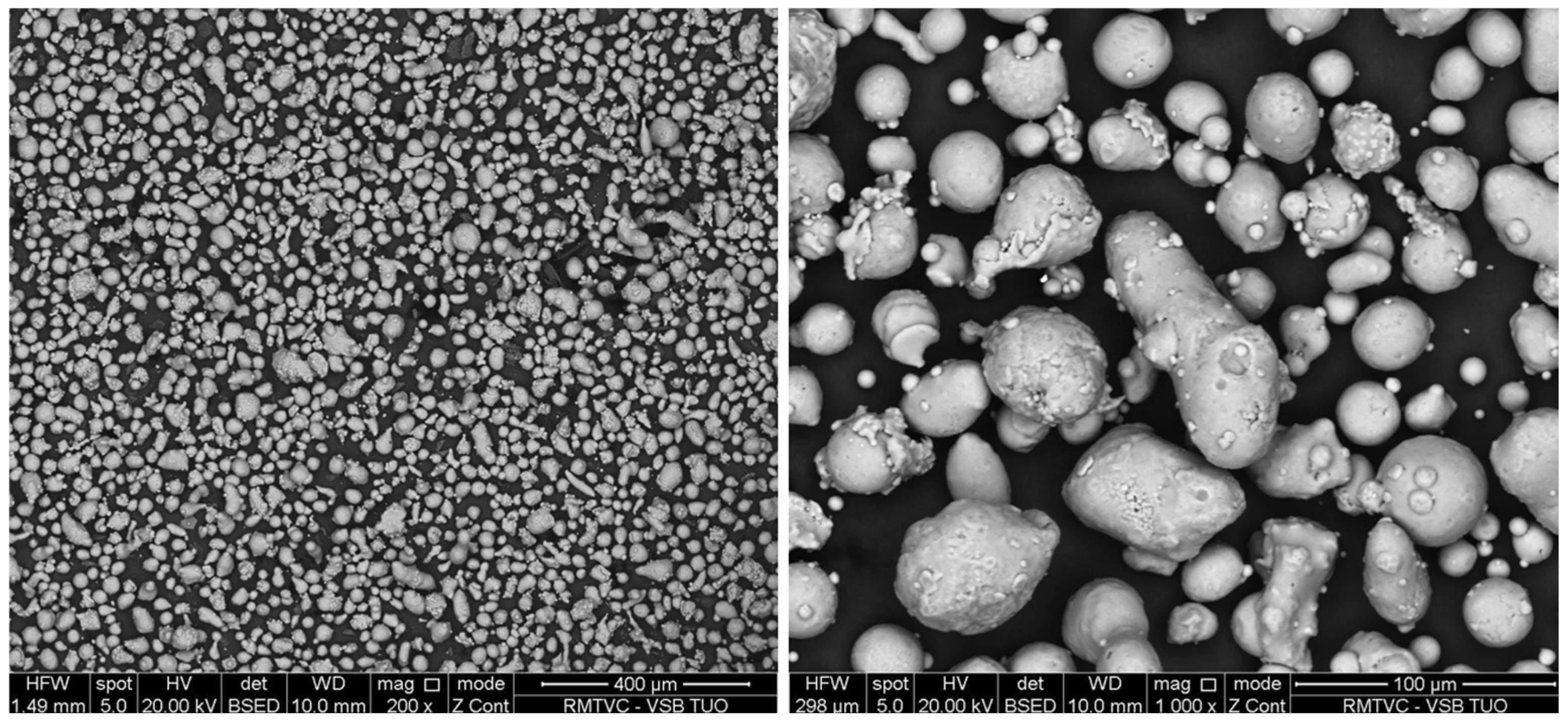
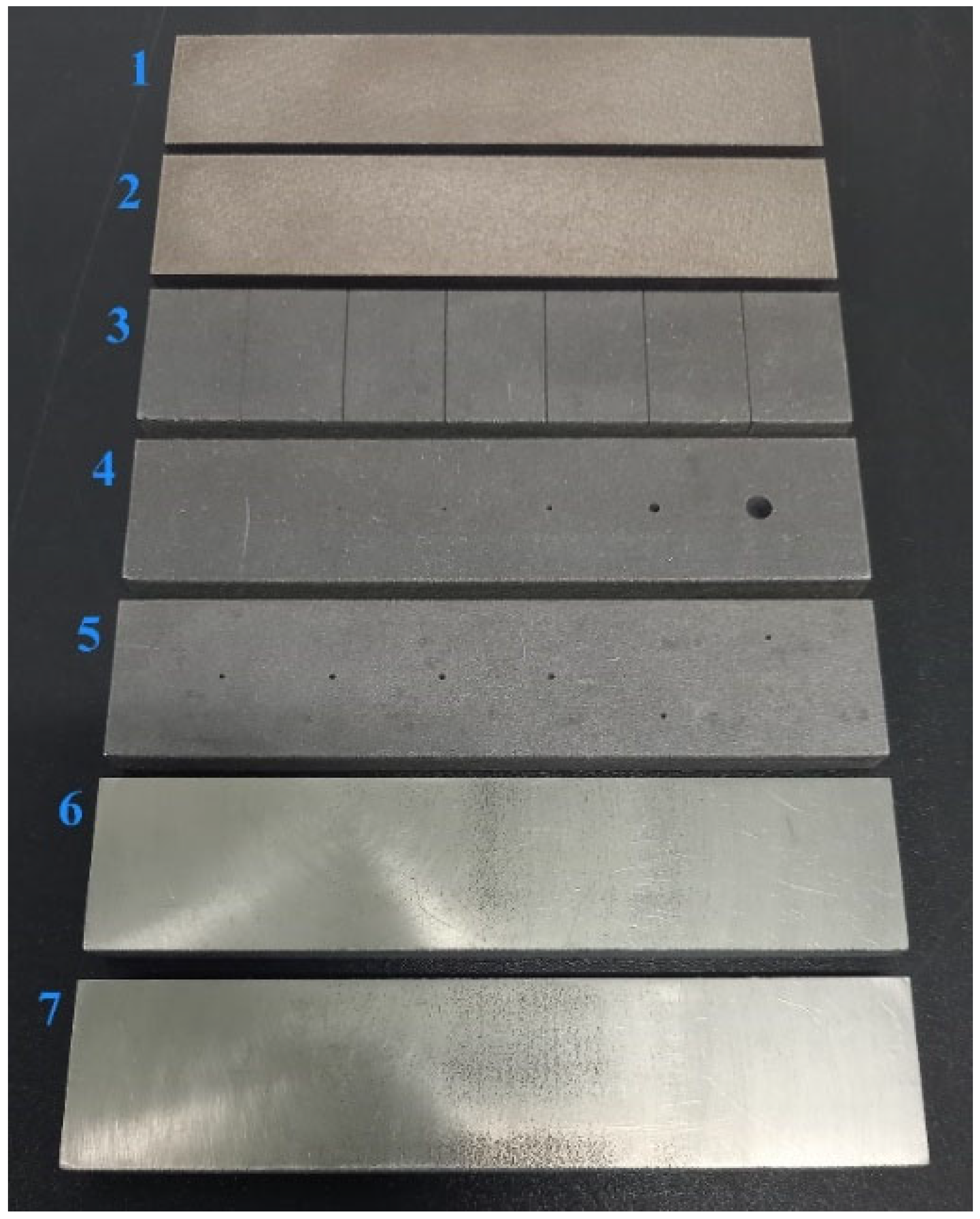
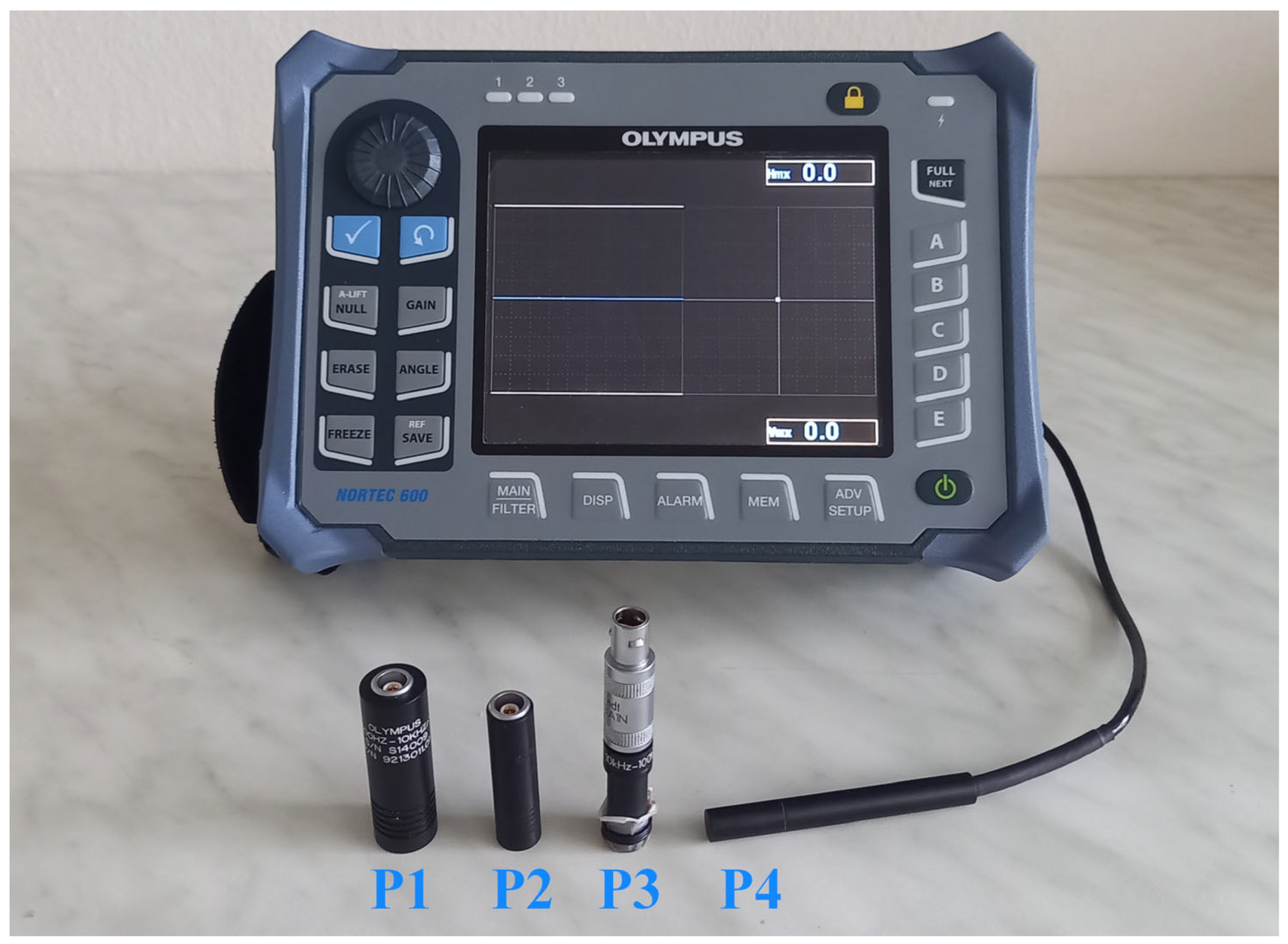


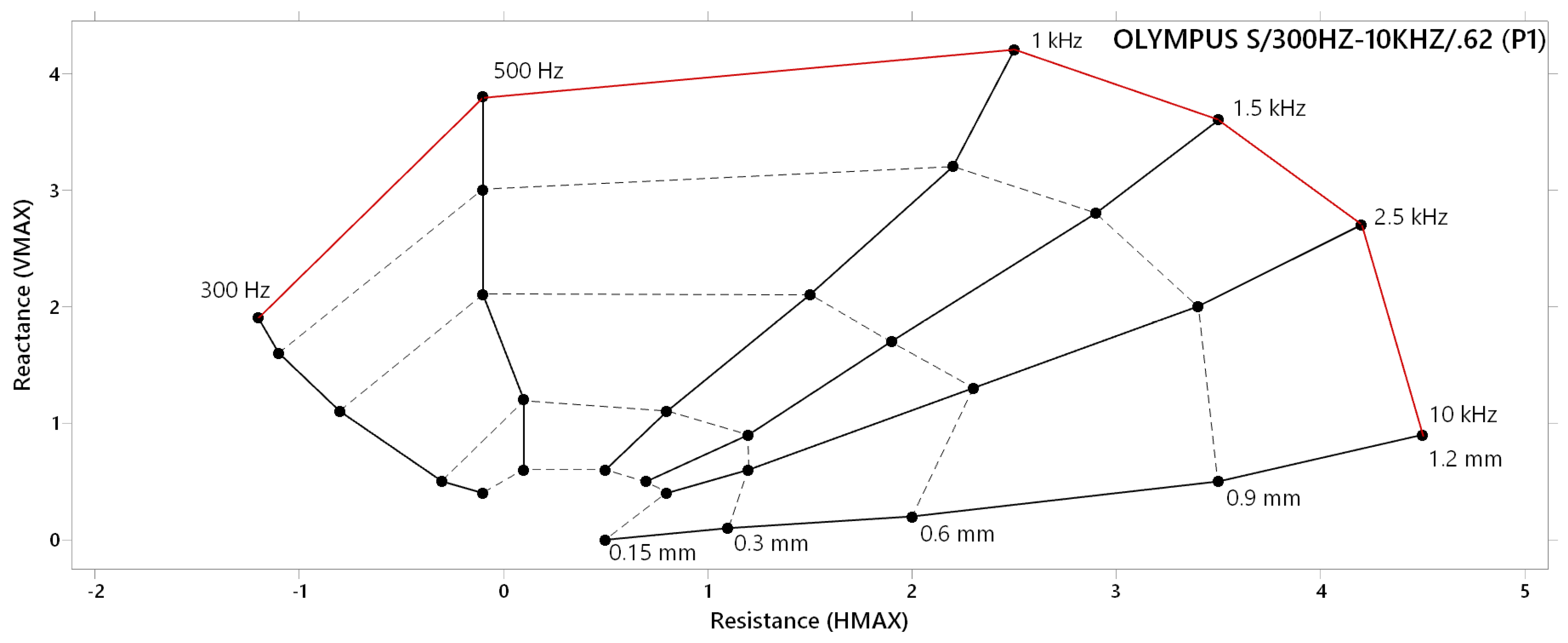
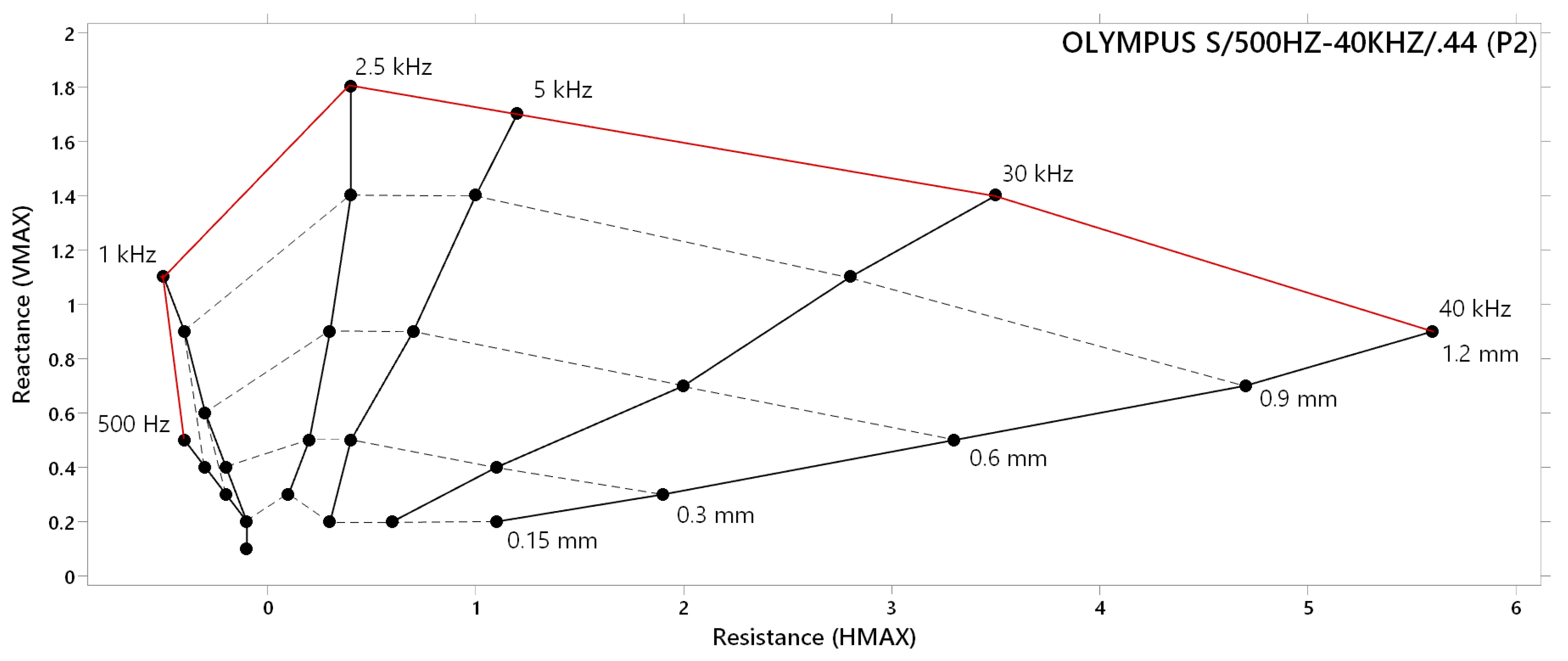

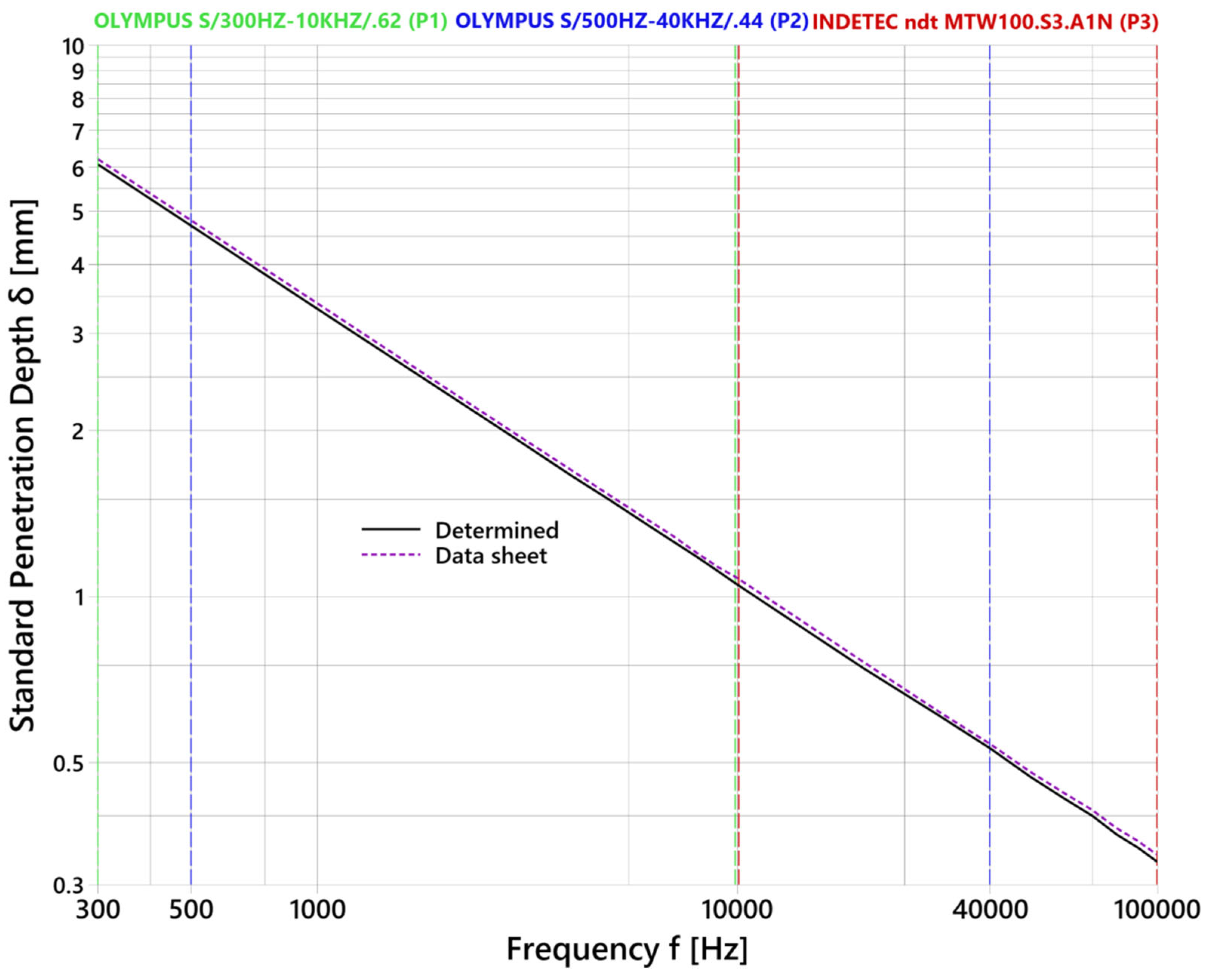





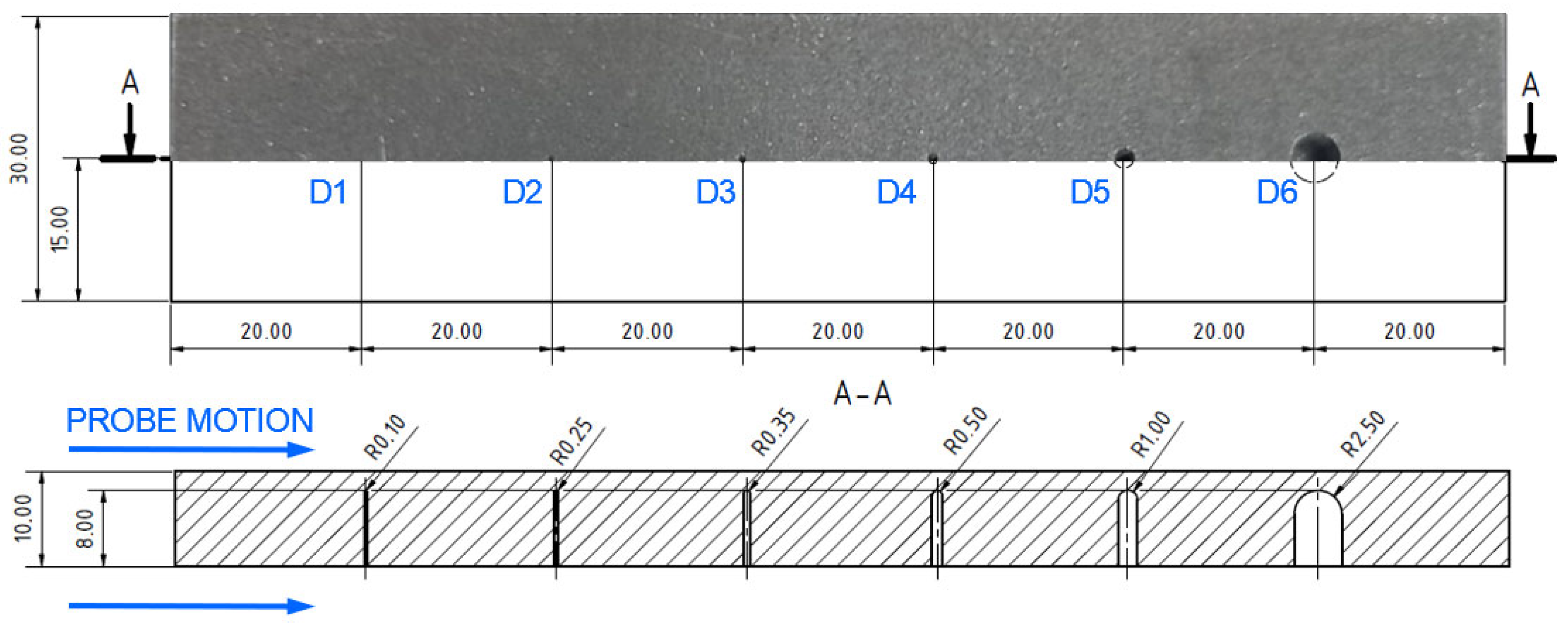


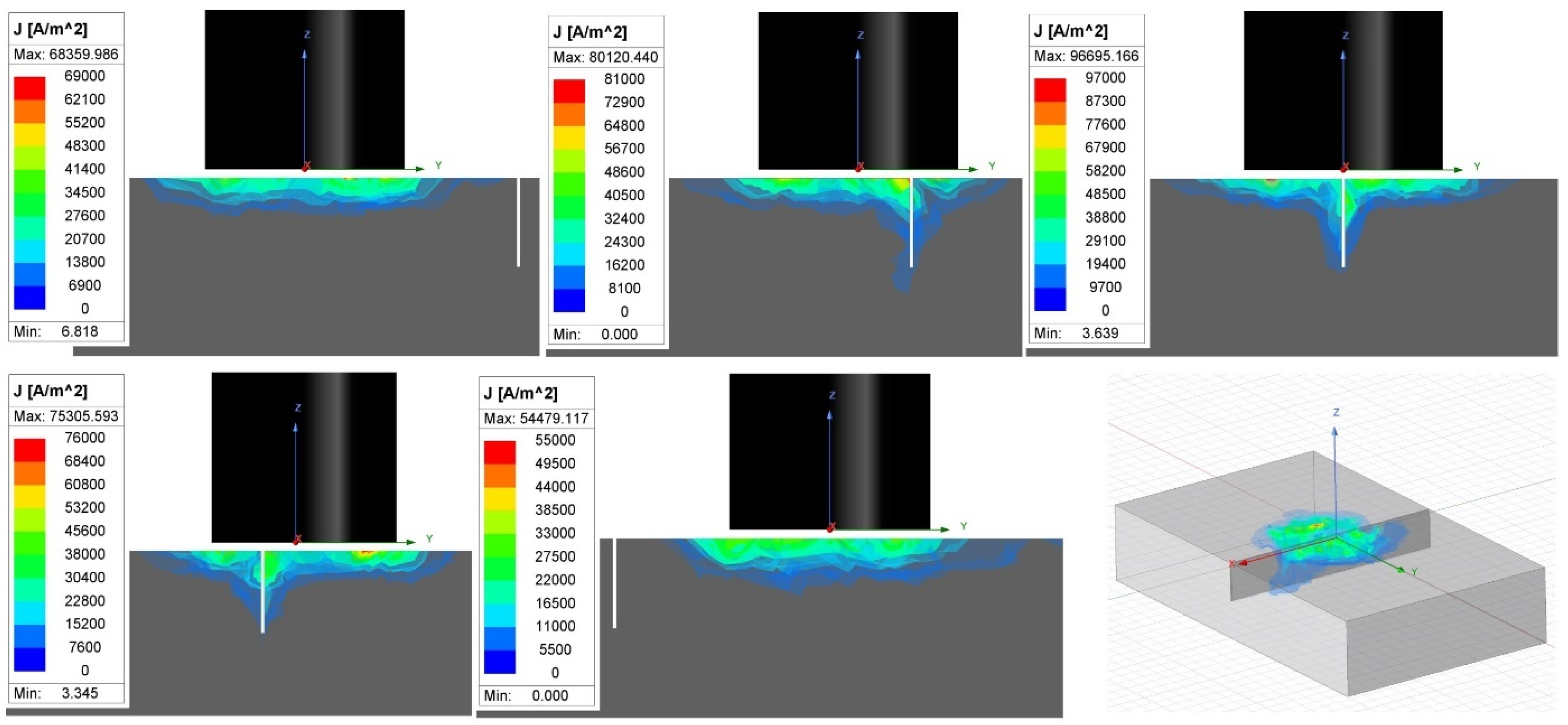
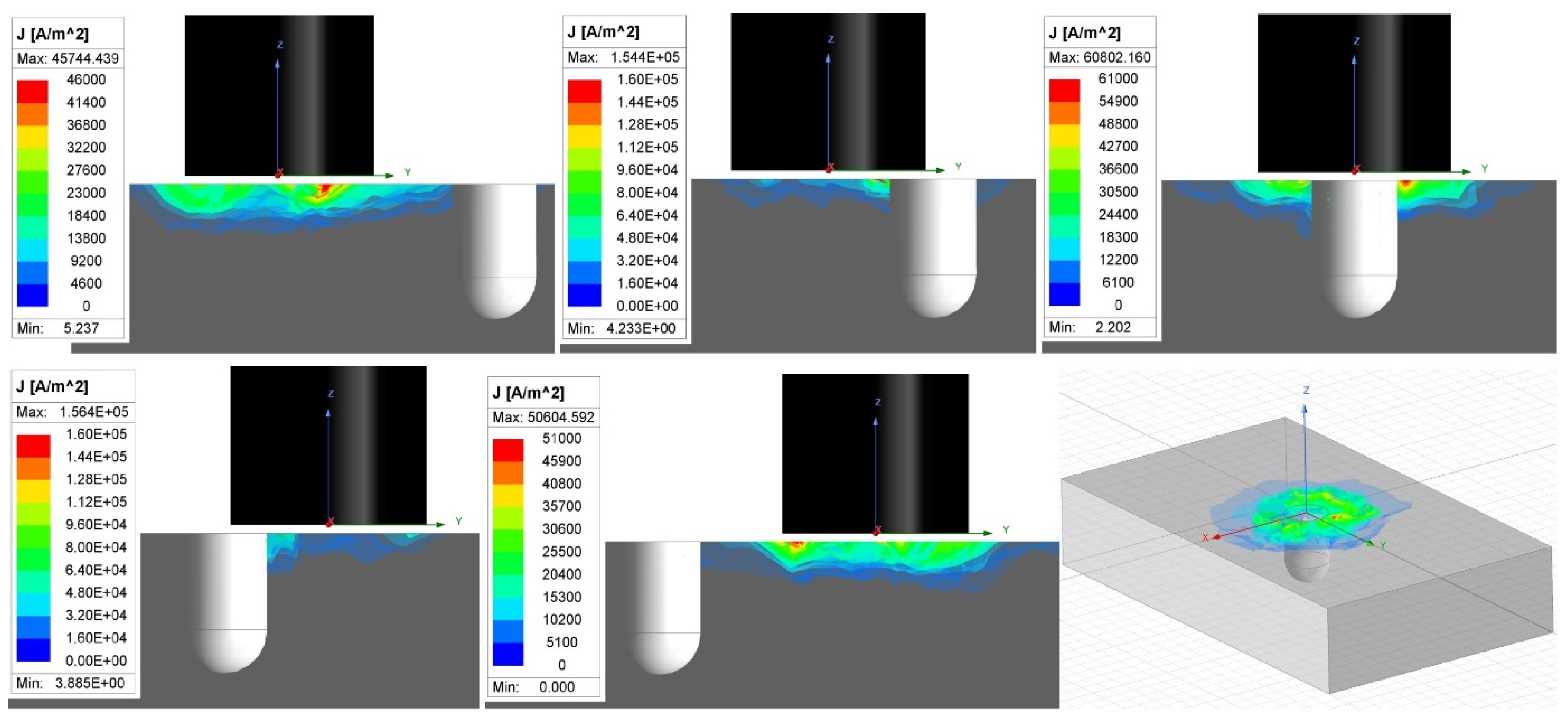

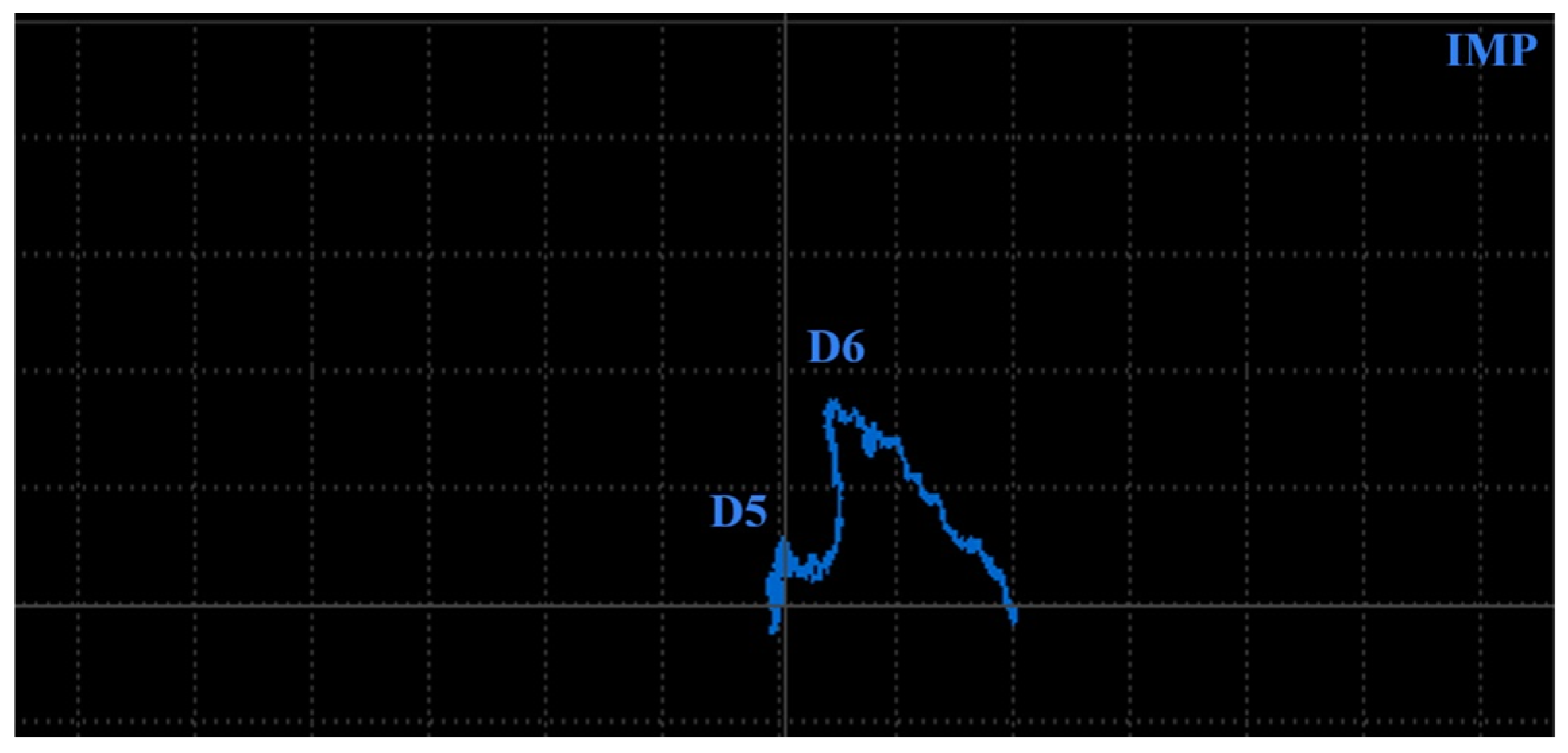
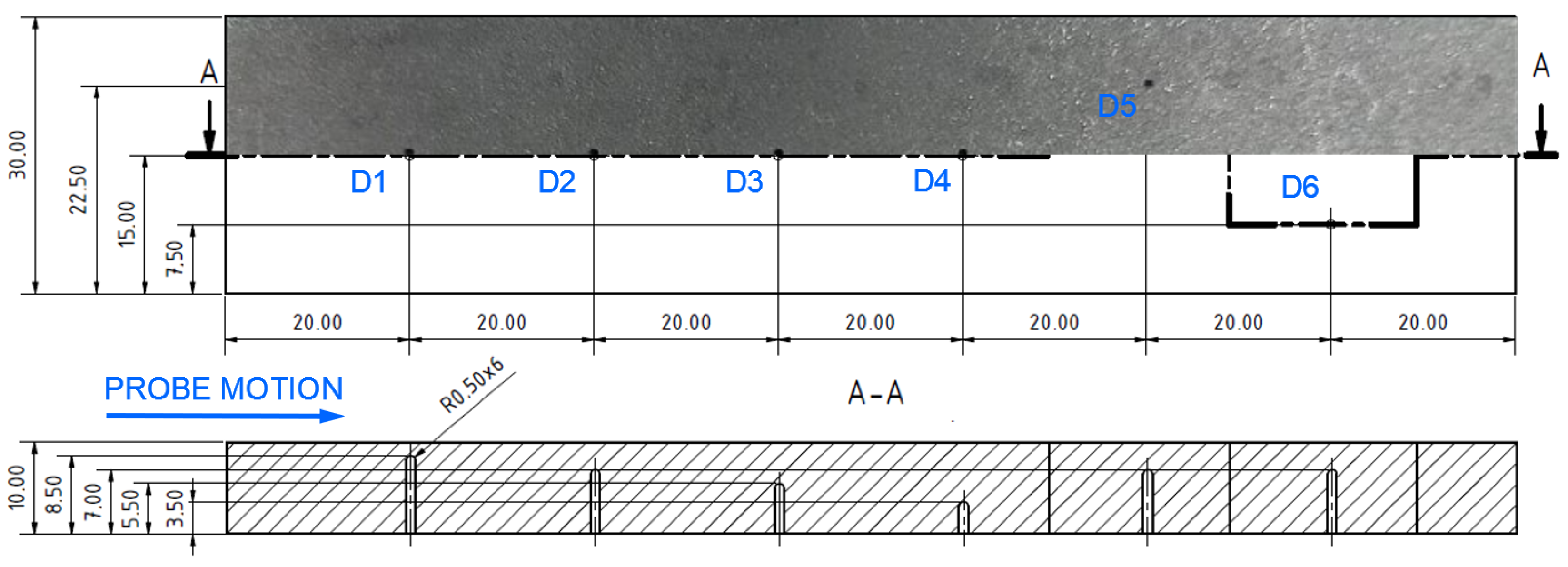
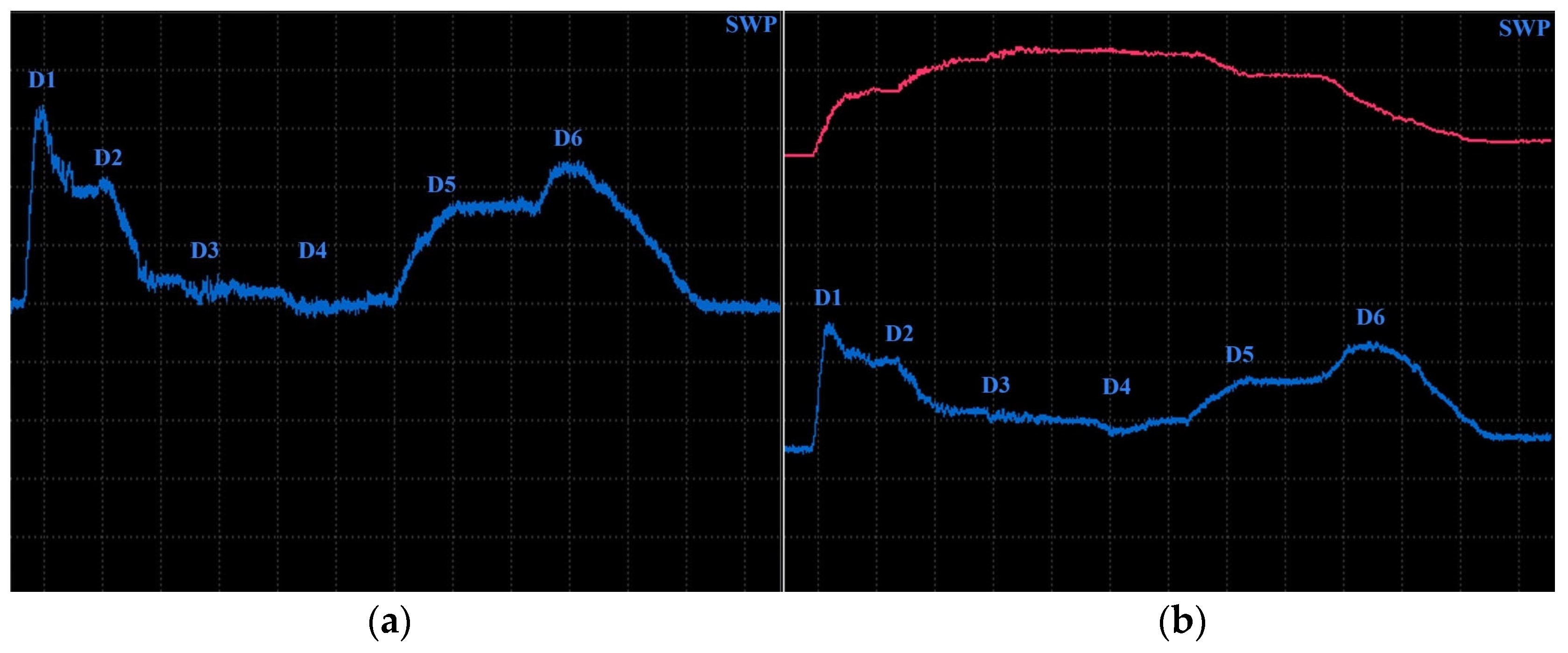
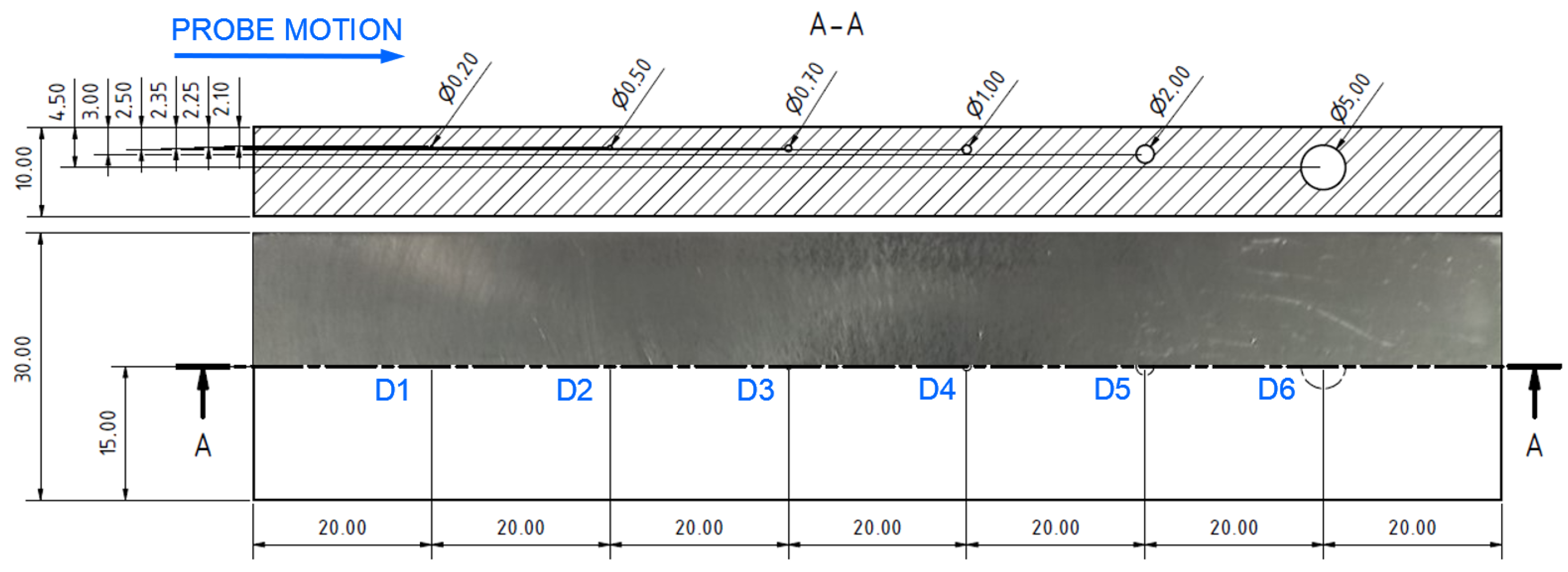
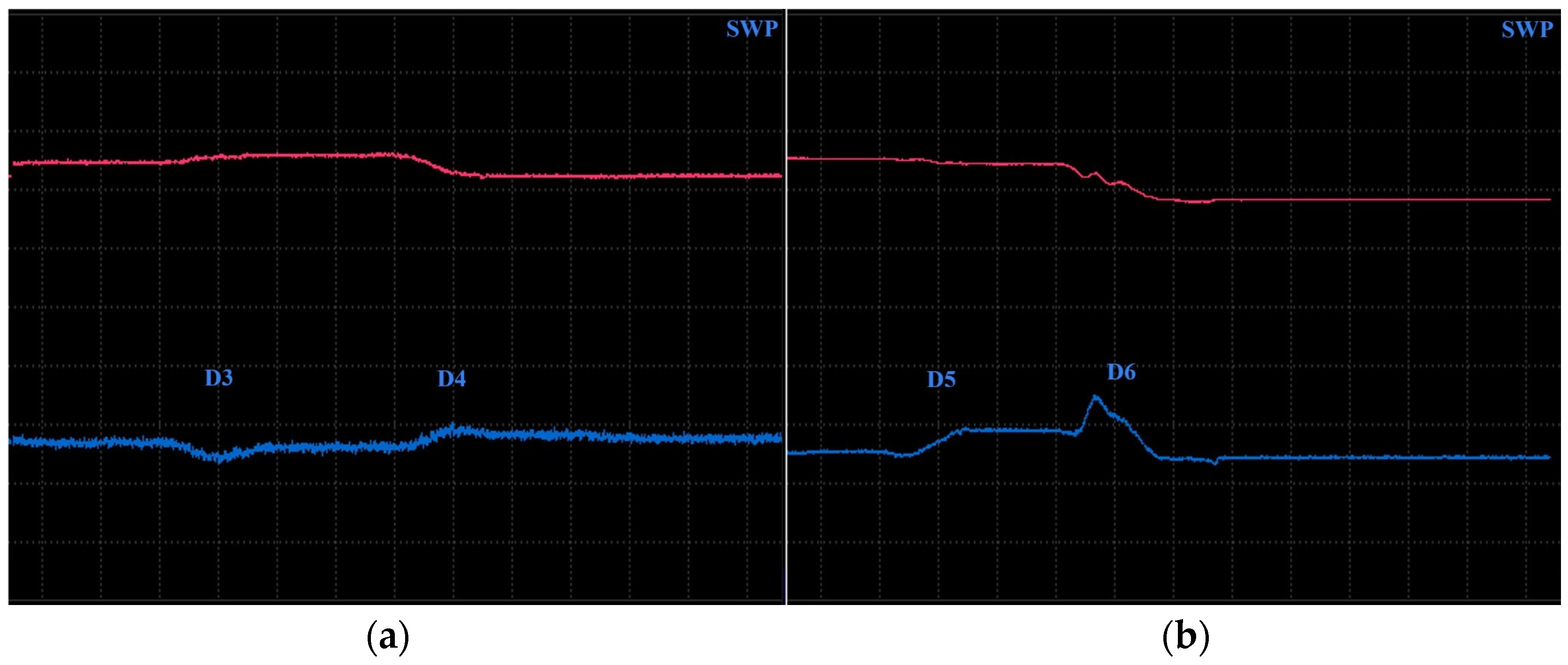
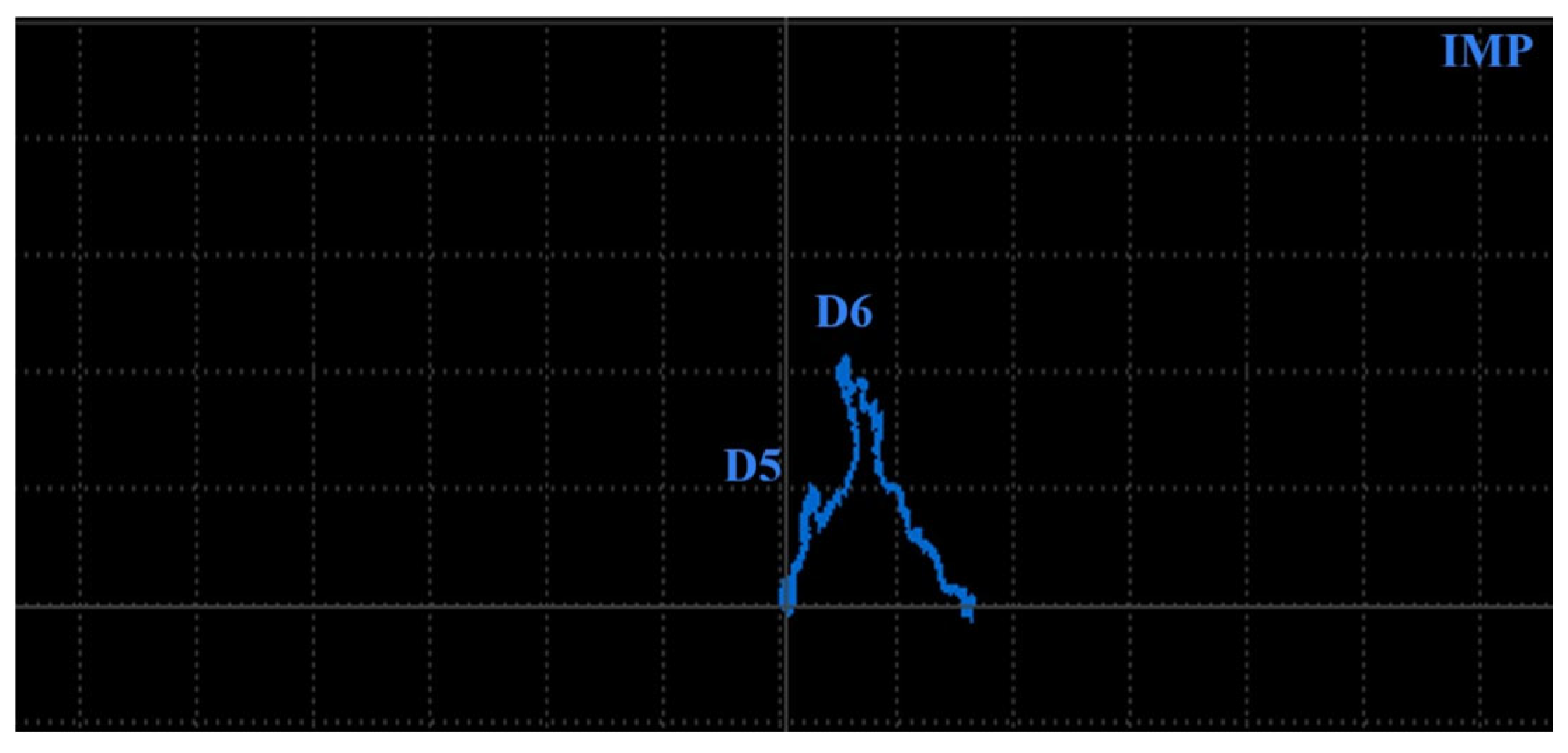


| Element | Al | Si | Fe | Cu | Mn | Mg | Ni | Zn | Pb | Ti | Sn |
|---|---|---|---|---|---|---|---|---|---|---|---|
| Mass (%) | Balance | 9–11 | ≤0.55 | ≤0.05 | ≤0.45 | 0.2–0.45 | ≤0.55 | ≤0.1 | ≤0.05 | ≤0.05 | ≤0.05 |
| Label | Probe | Type | Diameter [mm] | Frequency Range [kHz] |
|---|---|---|---|---|
| P1 | OLYMPUS S/300 HZ-10 KHZ/.62 | Absolute | 15.7 | 0.3–10 |
| P2 | OLYMPUS S/500 HZ-40 KHZ/.44 | Absolute | 11.2 | 0.5–40 |
| P3 | INDETEC ndt MTW100.S3.A1N | Absolute | 10 | 10–100 |
| P4 | OLYMPUS SPO-887L | Conductivity | 7.9 | 60 |
| Specimen | Defects | Probe | Regime | f [Hz] | VGAIN [dB] | HGAIN [dB] | ANGLE [°] | δ [mm] |
|---|---|---|---|---|---|---|---|---|
| 1 | D1–D4 | P2 | IMP | 2500 | 82 | 62.6 | 28 | 2.10 |
| 2 | D1–D4 | P2 | IMP | 2500 | 83.5 | 64.5 | 30 | 2.10 |
| 3 | D2–D3 | P2/P3 | IMP | 20,000 | 58 | 58 | 120 | 0.74 |
| D4–D6 | P2 | IMP | 2500 | 63 | 63 | 133 | 2.10 | |
| 4 (surface) | D2–D4 | P2/P3 | SWP | 20,000 | 65 | 55 | 20 | 0.74 |
| D5–D6 | P2 | SWP/IMP | 2500 | 68.4 | 70.7 | 133 | 2.10 | |
| 4 | D3–D4 | P2 | SWP | 1000 | 90 | 80 | 206 | 3.32 |
| D5–D6 | P2 | SWP/IMP | 1500 | 84 | 73 | 182 | 2.71 | |
| 5 | D1–D6 | P2 | SWP | 1000 | 90 | 80 | 225 | 3.32 |
| 6 | D3–D4 | P2 | SWP | 900 | 94 | 84 | 225 | 3.50 |
| D5–D6 | P2 | SWP/IMP | 1300 | 84 | 73 | 192 | 2.92 | |
| 7 | D1–D6 | P2 | SWP | 900 | 92.5 | 82.5 | 225 | 3.50 |
| Specimen | VMAX | HMAX | ||||||||||
|---|---|---|---|---|---|---|---|---|---|---|---|---|
| D1 | D2 | D3 | D4 | D5 | D6 | D1 | D2 | D3 | D4 | D5 | D6 | |
| 1 | 0 | 0.6 | 1.3 | 2.9 | - | - | −0.3 | 0 | 0 | −0.1 | - | - |
| 2 | −1.4 | −1.2 | −1.3 | −1.1 | - | - | 0 | 0.5 | 0.6 | 0.7 | - | - |
| 3 | - | 0.6 | 2.4 | 0.5 | 1.8 | 4 | - | 0.1 | 1.1 | 0.1 | 0.5 | 1.8 |
| 4 (surface) | - | 0.4 | 1.1 | 1.9/0.1 | 0.7 | 4 | - | 0.1 | 0.6 | 1.0/0.1 | 0.3 | 1.7 |
| 4 | - | - | −0.5 | −0.8 | 0.5 | 1.7 | - | - | −0.3 | −0.3 | 0.4 | 2 |
| 5 | 3.5 | 2.1 | 1.2 | 0.5 | 1.8 | 2.9 | −1.8 | −3.3 | −4.1 | −4.1 | −3.6 | −2.2 |
| 6 | - | - | 0.5 | 1.2 | 0.9 | 2.1 | - | - | 0.2 | 0.7 | 0.3 | 1.6 |
| 7 | 3.4 | 0.6 | −0.2 | −0.1 | 1 | 3.7 | −1.4 | −2.6 | −3.4 | −3 | −1.9 | −0.5 |
Disclaimer/Publisher’s Note: The statements, opinions and data contained in all publications are solely those of the individual author(s) and contributor(s) and not of MDPI and/or the editor(s). MDPI and/or the editor(s) disclaim responsibility for any injury to people or property resulting from any ideas, methods, instructions or products referred to in the content. |
© 2024 by the authors. Licensee MDPI, Basel, Switzerland. This article is an open access article distributed under the terms and conditions of the Creative Commons Attribution (CC BY) license (https://creativecommons.org/licenses/by/4.0/).
Share and Cite
Geľatko, M.; Hatala, M.; Botko, F.; Vandžura, R.; Hajnyš, J. Study of Eddy Current Testing Ability on SLM Aluminium Alloy. Materials 2024, 17, 3568. https://doi.org/10.3390/ma17143568
Geľatko M, Hatala M, Botko F, Vandžura R, Hajnyš J. Study of Eddy Current Testing Ability on SLM Aluminium Alloy. Materials. 2024; 17(14):3568. https://doi.org/10.3390/ma17143568
Chicago/Turabian StyleGeľatko, Matúš, Michal Hatala, František Botko, Radoslav Vandžura, and Jiří Hajnyš. 2024. "Study of Eddy Current Testing Ability on SLM Aluminium Alloy" Materials 17, no. 14: 3568. https://doi.org/10.3390/ma17143568
APA StyleGeľatko, M., Hatala, M., Botko, F., Vandžura, R., & Hajnyš, J. (2024). Study of Eddy Current Testing Ability on SLM Aluminium Alloy. Materials, 17(14), 3568. https://doi.org/10.3390/ma17143568








